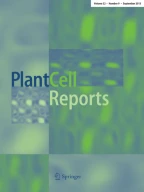Abstract
The aims of the investigation were to characterise variability among the DNA amounts of roses and assess the predictability of ploidy levels from DNA amounts. Chromosome numbers in the genus Rosa range from 2n = 2x = 14 to 2n = 8x = 56 and aneuploidy is rare. Published 2C DNA amounts range from 0.78 pg in R. xanthina Lindl. and R. sericea Lindl. (2n = 2x = 14) to 2.91 pg in R. canina L. (2n = 5x = 35). In this investigation, DNA amounts were estimated by flow cytometry of leaf nuclei stained with propidium iodide, using Petroselinum crispum (2C DNA amount = 4.46 pg) as the internal calibration standard. Ploidy levels based on DNA amounts (DNA ploidy) were assigned by comparing their DNA amounts with published DNA amounts and identifying peaks and intervening discontinuities in frequency distributions of DNA amounts. 2C DNA amounts ranged from 0.83 pg in R. ecae (2x = 2x = 14) to 3.99 pg in R. acicularis (2n = 8x = 56). Differences in the 1Cx-values (2C DNA amount/ploidy values) were found among the taxonomic sections of Rosa. Ploidy levels could be confidently assigned to most species and cultivars, but the ploidy of some specimens in the section Caninae was uncertain for reasons attributed to genomic diversity and aneuploidy. Cytochimerism was detected in three cultivars of R. × alba. DNA ploidy was determined in 384 specimens representing 74 species and 5 horticultural classes.



Similar content being viewed by others
References
Akasaka M, Ueda Y, Koba T (2003) Karyotype analysis of wild rose species belonging to septets B, C and D by molecular cytogenetic method. Breed Sci 53:177–182
Allum JF, Bringloe DH, Roberts AV (2007) Chromosome doubling in a Rosa rugosa Thunb. hybrid by exposure of in vitro nodes to oryzalin: the effects of node length, oryzalin concentration and exposure time. Plant Cell Rep 26:1977–1984. doi:10.1007/s00299-007-0411-y
Brumme H, Gladis Th (2006) Vorarbeiten zur Inventarisierung pflanzengenetischer Ressourcen in Deutschland—Die Wildrosen (Gattung Rosa L.) im Europa-Rosarium Sangerhausen. In: Europa-Rosarium Sangerhausen (ed) Wildrosenverzeichnis, 5th edn. Möbius, Artern, pp 64–106
Brumme H, Gladis Th (2007) Vorarbeiten zur Inventarisierung pflanzengenetischer Ressourcen in Deutschland—Die Wildrosen (Gattung Rosa L.) im Europa-Rosarium Sangerhausen, nach ihrer Verwandtschaft geordnet, 6th edn. http://rosarium-verein.de/cmsupload/Wildrosenverzeichnis.pdf, http://www.das-rosen-netzwerk.de/index.php?seite=drn_wrers
Cairns T (ed) (2003) Modern roses XI. Academic, San Diego
Cave MS (ed) (1958–1960) Index to plant chromosome numbers 1956–1959 series. University of North Carolina Press, Chapel Hill
Crane YM, Byrne DH (2003) Karyology. In: Roberts AV, Debener T, Gudin S (eds) Encyclopedia of rose science. Elsevier/Academic, London, pp 267–273
Darlington CD, Wylie AP (1955) Chromosome atlas of flowering plants, 2nd edn. Allen and Unwin, London
Doležel J, Greilhuber J, Suda J (2007) Estimation of nuclear DNA content in plants using flow cytometry. Nat Protoc 2:2223–2244. doi:10.1038/nprot.2007.310
Goldblatt P, Johnson DE (eds) (2006) Index to plant chromosome numbers 2001–2003. Missouri Botanic Garden, St Louis
Greilhuber J (1988) ‘Self-tanning’—a new and important source of stoichiometric error in cytophotometric determination of nuclear DNA content in plants. Plant Syst Evol 158:87–96
Greilhuber J, Doležel J, Lysák MA, Bennett MD (2005) The origin, evolution and proposed stabilization of the terms ‚genome size and ‚c-value to describe nuclear DNA contents. Ann Bot 95:255–260. doi:10.1093/aob/mci019
Gudin S (2000) Rose: genetics and breeding. Plant Breed Rev 17:159–189
Hanson L, Boyd A, Johnson MAT, Bennett MD (2005) First nuclear DNA C-values for 18 Eudicot families. Ann Bot 96:1315–1320. doi:10.1093/aob/mci283
Lim KY, Werlemark G, Matyasek R, Bringloe JB, Sieber V, El Mokadem H, Meynet J, Hemming J, Leitch AR, Roberts AV (2005) Evolutionary implications of permanent odd polyploidy in the stable sexual, pentaploid of Rosa canina L. Heredity 94:501–506. doi:10.1038/sj.hdy.6800648
Missouri Botanic Garden (1978–2000) Index to plant chromosome numbers. http://mobot.mobot.org/W3T/search/ipcn.html
Moore RJ (ed) (1970–1974) Index to plant chromosome numbers 1968–1972 series. Bohn and Scheltema for the International Bureau for Plant Taxonomy and Nomenclature, Utrecht
Ornduff R (ed) (1967–1969) Index to plant chromosome numbers 1965–1967 series. Bohn and Scheltema for the International Bureau for Plant Taxonomy and Nomenclature, Utrecht
Ornduff R (ed) (1977) Index to plant chromosome numbers 1973–1974 series. Bohn and Scheltema for the International Bureau for Plant Taxonomy and Nomenclature, Utrecht
Roberts AV (1977) Relationships between species in the genus Rosa section Pimpinellifoliae. Bot J Linn Soc 74:309–328
Roberts AV (2007) The use of bead beating to prepare suspensions of nuclei for flow cytometry from fresh leaves, herbarium leaves, petals and pollen. Cytometry A 71A:1039–1044. doi:10.1002/cyto.a.20486
Sokal RR, Rolfe FJ (1995) Biometry, 3rd edn. WH Freeman and Company, New York
Suda J, Krahulcova A, Travnicek P, Krahulec F (2006) Ploidy level versus DNA ploidy level: an appeal for consistent terminology. Taxon 55:447–450
Thomas GS (1994) The Graham Stuart Thomas rose book. John Murray, London
Werlemark G (2003) Inheritance in the dog rose. In: Roberts AV, Debener T, Gudin S (eds) Encyclopedia of rose science. Elsevier/Academic, London, pp 292–299
Wylie AP (1954) The history of garden roses. J Roy Hortic Soc 79:555–571
Wylie AP (1955a) The history of garden roses. Part 2. J Roy Hortic Soc 80:8–24
Wylie AP (1955b) The history of garden roses. Part 3. J Roy Hortic Soc 80:77–87
Yokoya K, Roberts AV, Mottley J, Lewis R, Brandham PE (2000) Nuclear DNA amounts in roses. Ann Bot 85:557–561. doi:10.1006/ambo.1999
Acknowledgements
This report is based on a pilot project, which was supported by funds of the German Federal Ministry of Food, Agriculture and Consumer Protection but the responsibility for the content of the publication rests with the authors. We thank the town of Sangerhausen and the foundation Europa-Rosarium Sangerhausen in the Association of German Rose Friends (Gesellschaft Deutscher Rosenfreunde e. V.) for their support.
Author information
Authors and Affiliations
Corresponding author
Additional information
Communicated by R. Rose.
Electronic supplementary material
Below is the link to the electronic supplementary material.
Rights and permissions
About this article
Cite this article
Roberts, A.V., Gladis, T. & Brumme, H. DNA amounts of roses (Rosa L.) and their use in attributing ploidy levels. Plant Cell Rep 28, 61–71 (2009). https://doi.org/10.1007/s00299-008-0615-9
Received:
Revised:
Accepted:
Published:
Issue Date:
DOI: https://doi.org/10.1007/s00299-008-0615-9



